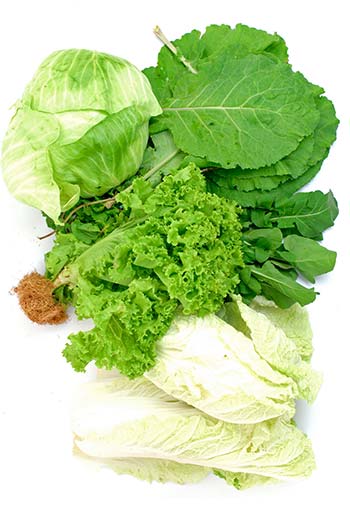 Summer is a great time to “green up” your diet by eating more fresh or cooked greens. Green leafy vegetables are in season in Missouri in the early summer and then again in the fall. This includes those greens most commonly seen in grocery stores, like spinach, kale, collards, mustard greens or Swiss chard. The tops of many root vegetables, such as beets, turnips and rutabagas, can also be eaten as greens. Leaves from some wild plants, such as dandelions and lambs quarters, can be eaten as well; however, be sure to confirm that wild greens are safe for human consumption before serving or eating them.
Summer is a great time to “green up” your diet by eating more fresh or cooked greens. Green leafy vegetables are in season in Missouri in the early summer and then again in the fall. This includes those greens most commonly seen in grocery stores, like spinach, kale, collards, mustard greens or Swiss chard. The tops of many root vegetables, such as beets, turnips and rutabagas, can also be eaten as greens. Leaves from some wild plants, such as dandelions and lambs quarters, can be eaten as well; however, be sure to confirm that wild greens are safe for human consumption before serving or eating them.
Greens should be stored in a perforated bag with a moist paper towel to keep them fresh. They can last up to a week in the refrigerator. To prepare them for use, wash them thoroughly on both sides to remove any soil that clings to them. Spinning in a salad spinner or allowing to drip dry removes excess moisture that may be undesirable when eating or cooking. Greens can be eaten fresh in a salad or cooked.
There has been some debate as to whether greens are more nutritious fresh or cooked. In the May 2014 issue of Tufts Health and Nutrition Letter, Diane L. McKay, assistant professor at Tufts University’s Friedman School, indicates that both methods of preparing greens can be a healthy choice. She reports that cooking breaks down the cell walls and “releases some of the phytochemicals like the carotenoids and ferulic acid that are present in the plant, making more of them available to your body when consumed.” These compounds are important for good health, making cooked greens a good option. On the other hand, the amount of water-soluble vitamins present in greens, like vitamin C and the B vitamins, decreases with cooking, so fresh has its advantages as well. Either way, dark green leafy vegetables are an excellent source of vitamin K, which is important in the clotting of blood needed to heal wounds.
MU Extension publication, MP909, Seasonal and Simple: A Guide for Enjoying Fresh Fruits and Vegetables, offers more information on how to store, prepare and serve greens, as well as some recipes. You can buy the Seasonal and Simple guide at https://extension.missouri.edu/publications/mp909, or use the free app or the website at http://seasonalandsimple.info.
Find creative and nutritious ways to eat more greens, especially while they are in season and more readily available as well as less expensive.